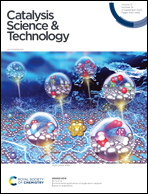In situ construction of a Sillén–Aurivillius layered perovskite-based 0D/2D homologous Schottky junction for efficient piezo-photocatalytic activity†
Abstract
The interface shielding effect resulting from the accumulation of charge carriers and the relatively weak driving force provided by the single built-in electric field in conventional heterojunctions seriously hamper the rapid and continuous charge separation. Herein, focusing on Sillén–Aurivillius perovskite-type bismuth tantalum oxyhalides, an ingenious 0D/2D Bi/Bi4TaO8Cl0.5Br0.5 (BTOCB) piezoelectric homologous Schottky heterojunction is judiciously designed and fabricated via in situ deposition of Bi nanodots on the surfaces of BTOCB solid solution nanosheets and shows mainly exposed (001) facets and strong piezoelectricity. Rietveld refinements confirm the substitution of Cl and Br in the lattice, and the band structure is regulated by solid solution engineering. Meanwhile, the introduction of Bi improves visible light absorption and creates an internal electric field at the heterointerface. Under the synergetic action of illumination and ultrasonic vibration, the unique multi-internal electric field modulation derived from the piezoelectric polarization and Schottky junction can break the heterointerface shielding effect and deliver powerful driving force for impactful spatial photocarrier migration and separation. As a result, the as-prepared Bi/BTOCB Schottky junction exhibits outstanding piezo-photocatalyst performance for tetracycline (TC) degradation. Lastly, the possible degradation pathway of TC is proposed, and the toxicity of intermediates is also analyzed. This study demonstrates a strategy of multi-field modulation in optimizing photogenerated carrier behaviors and gives deep insights into the design of high-performance piezo-photocatalysts.



 Please wait while we load your content...
Please wait while we load your content...